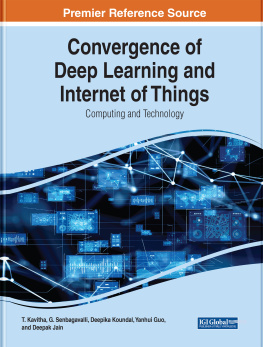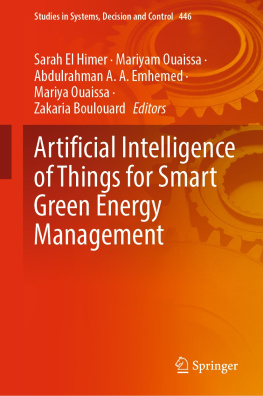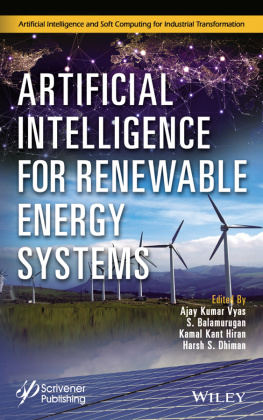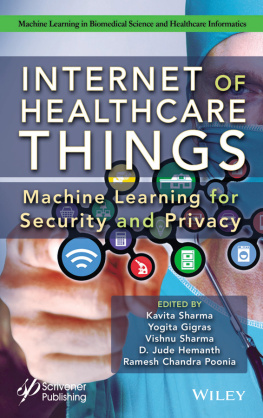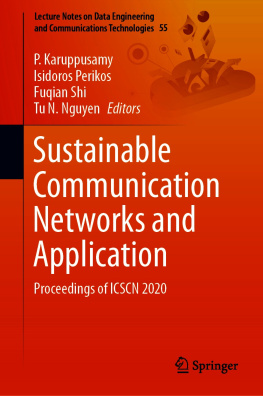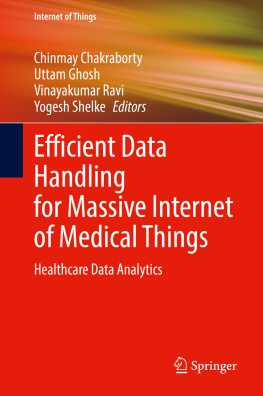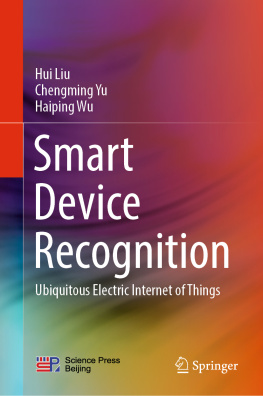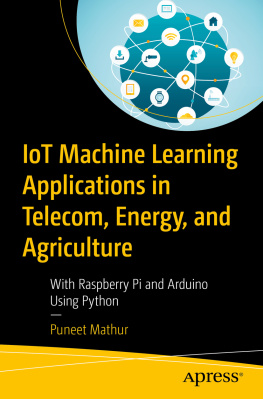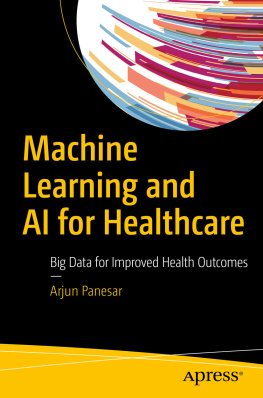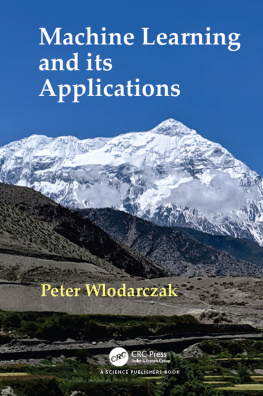
Scrivener Publishing
100 Cummings Center, Suite 541J
Beverly, MA 01915-6106
Publishers at Scrivener
Martin Scrivener ()
Phillip Carmical ()
Green Internet of Things and Machine Learning
Towards a Smart Sustainable World
Edited by
Roshani Raut
Sandeep Kautish
Zdzislaw Polkowski
Anil Kumar
and
Chuan-Ming Liu

This edition first published 2022 by John Wiley & Sons, Inc., 111 River Street, Hoboken, NJ 07030, USA and Scrivener Publishing LLC, 100 Cummings Center, Suite 541J, Beverly, MA 01915, USA
2022 Scrivener Publishing LLC
For more information about Scrivener publications please visit www.scrivenerpublishing.com.
All rights reserved. No part of this publication may be reproduced, stored in a retrieval system, or transmitted, in any form or by any means, electronic, mechanical, photocopying, recording, or otherwise, except as permitted by law. Advice on how to obtain permission to reuse material from this title is available at http://www.wiley.com/go/permissions.
Wiley Global Headquarters
111 River Street, Hoboken, NJ 07030, USA
For details of our global editorial offices, customer services, and more information about Wiley products visit us at www.wiley.com.
Limit of Liability/Disclaimer of Warranty
While the publisher and authors have used their best efforts in preparing this work, they make no representations or warranties with respect to the accuracy or completeness of the contents of this work and specifically disclaim all warranties, including without limitation any implied warranties of merchantability or fitness for a particular purpose. No warranty may be created or extended by sales representatives, written sales materials, or promotional statements for this work. The fact that an organization, website, or product is referred to in this work as a citation and/or potential source of further information does not mean that the publisher and authors endorse the information or services the organization, website, or product may provide or recommendations it may make. This work is sold with the understanding that the publisher is not engaged in rendering professional services. The advice and strategies contained herein may not be suitable for your situation. You should consult with a specialist where appropriate. Neither the publisher nor authors shall be liable for any loss of profit or any other commercial damages, including but not limited to special, incidental, consequential, or other damages. Further, readers should be aware that websites listed in this work may have changed or disappeared between when this work was written and when it is read.
Library of Congress Cataloging-in-Publication Data
ISBN 978-1-119-79203-1
Cover image: Pixabay.Com
Cover design by Russell Richardson
Set in size of 11pt and Minion Pro by Manila Typesetting Company, Makati, Philippines
Printed in the USA
10 9 8 7 6 5 4 3 2 1
Preface
The Internet of Things (IoT) is an evolving idea which is responsible for connecting billions of devices that acquire, perceive, and communicate data from their surroundings. Because this transmission of data uses significant energy, improving energy efficiency in IOT devices is a significant topic for research. The green internet of things (G-IoT) makes it possible for IoT devices to use less energy since intelligent processing and analysis are fundamental to constructing smart IOT applications with large data sets. Machine learning (ML) algorithms that can predict sustainable energy consumption can be used to prepare guidelines to make IoT device implementation easier.
The G-IoT, an updated version of the IoT, is applied for different applications to improve energy efficiency. Therefore, the material collected in this book has been edited to enhance the readers knowledge about the current research achievements and challenges in the area of G-IoT and ML applications. The book targets senior and junior engineers, undergraduate and postgraduate students, researchers, and anyone else interested in the trends, developments, and opportunities afforded by the G-IoT and ML concepts.
Although it was impossible to include all current aspects of the research in the targeted area in the twelve chapters of this book, it will be a useful tool in terms of the various possible methodologies that can provide G-IoT applications through the use of ML. A brief description of the various application fields and methodologies covered in each chapter follows:
- provides a brief introduction to various artificial intelligence (AI), ML, and IoT-based approaches with their real-life applications. It encompasses the many aspects of the G-IoT based on IoT device use and presents an outline of how each web search engine, such as Bing or Google, is used to search the internet, as they employ strategies such as learning algorithms to rank the websites. For example, every time Facebook is used to identify the photo of friends, online fraud detection, online customer assistance, video surveillance, face recognition, email spam, and malware are based on various learning algorithms.
- presents an AI equipment design that focuses on IoT applications. The design is established on the standard of learning automata, characterized by utilizing propositional logic. The reasoning-based support empowers low-vitality impressions just as high learning accuracy throughout is used for preparing and surmising, which are vital criteria for competent AI with a long working life. Methodical encoding of the input information into optimally equal reasoning blocks is essential to this circuit. The distribution of these squares is improved through a plan investigation and robotization stream utilizing field programmable entryway exhibit-based quick models and programming recreations. The plan stream considers an assisted hyperparameter search for matching the clashing demands of economy and high accuracy. Broad approvals of the equipment execution of the new engineering employing single- and multiclass AI datasets reveal potential for fundamentally reduced vitality compared to the current AI equipment structures.
- focuses on the IoT as a technology that connects everything to the smart world. To develop a practical smart scenario, this chapter explores numerous technologies along with the difficulties involved in fulfilling the goal of a G-IoT. Since energy-efficient communication in large-scale IoT devices has become a key concern in recent years, there is a fundamental need in such networks to minimize overall battery-powered device power consumption to reduce data transmission costs and lengthen network life. This study requires a scalable and energy-efficient approach for G-IoT heterogeneous nodes. These nodes need to create energyefficient power conservation mechanisms to provide a longlived network.
- discusses the role of ML and the G-IoT in agriculture. Machine learning and its various application domains are explained and extensively covered in the first part of the chapter. In agricultural and farming applications, there are pros and cons to using the IoT to preserve biodiversity and reduce greenhouse gas emissions. To minimize the drawbacks, the smart food and agricultural enterprises built using G-IoT and green nanotechnology are discussed. Furthermore, how the IoT and G-IoT empower agriculture with accurate and sustainable farming approaches is also discussed.
- demonstrates the use of analytics and machine learning to improve crop data. For optimal crop growth, pH, water content, and humidity are key. Inadequate inputs might lead to a growth imbalance in crops. Machine learning approaches can profit from prediction and classification challenges. To monitor the health of crops in the field, CIoT (Crop Internet of Things) was mostly required to assist in humidity, soil pH, soil wetness, soil type, and crop quality monitoring. Various sensors, like humidity sensors, pH sensors, soil quality sensors, and temperature sensors, can be utilized to detect crop yield and ML algorithms to calculate yields alongside descriptive analytics. Decisions on types of pesticides to use and the nutritional requirements of individual crops can be made with ML algorithms. Farmers would benefit from the early use of ML for soil mapping to produce a better environment for future crops.
Next page

